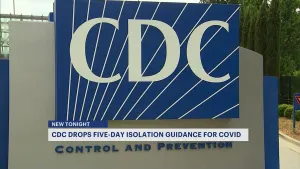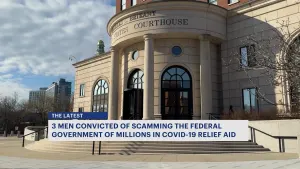The New Normal: CDC loosens COVID-19 protocols for schools. What it means for our students.
News 12's Elizabeth Hashagen was joined by Dr. Christina Johns, pediatric emergency care physician and senior medical advisor for PM Pediatric Care.
•
Aug 22, 2022, 2:22 PM
•
Updated 1,167 days ago
Share:
More Stories
0:22

Cold Spring Village Hall closed due to COVID-19 surge and staff shortages
420ds ago
Hometown Heroes in the Hudson Valley
467ds ago1:28

Medical experts recommend to still take precautions following CDC's revised COVID isolation guidelines
611ds ago1:52

Judge: 3 men convicted in COVID-19 relief aid fraud
632ds ago1:47

Wondrous Things store in Briarcliff Manor to close after 34 years; everything 25% off
759ds ago0:28

Rockland small businesses get COVID-19 reimbursement grant
760ds ago0:22

Cold Spring Village Hall closed due to COVID-19 surge and staff shortages
420ds ago
Hometown Heroes in the Hudson Valley
467ds ago1:28

Medical experts recommend to still take precautions following CDC's revised COVID isolation guidelines
611ds ago1:52

Judge: 3 men convicted in COVID-19 relief aid fraud
632ds ago1:47

Wondrous Things store in Briarcliff Manor to close after 34 years; everything 25% off
759ds ago0:28

Rockland small businesses get COVID-19 reimbursement grant
760ds agoSchool is just about to start for children across the tri-state. Along with new backpacks and clothes -- are new COVID-19 guidelines and a bit of confusion for parents.
News 12's Elizabeth Hashagen was joined by Dr. Christina Johns, pediatric emergency care physician and senior medical advisor for PM Pediatric Care.
The Centers for Disease Control and Prevention released updated recommendations largely loosening virus protocols and leaving much of the decision-making to individuals and local officials.
For the start of school this year, it may very well feel more like the days before the COVID-19 pandemic, as the school system rolls back restrictions, including an end to in-school PCR testing and the requirement that families fill out a daily health screening form.
The changes reflect the CDC shift toward learning how to live with the virus instead of allowing it to disrupt life.
The agency no longer recommends that people stay 6 feet away from others or that people who are exposed to COVID-19 quarantine at home, although it recommends that they still wear a mask for 10 days.
WHAT HAPPENS IF I HAVE BEEN EXPOSED TO COVID-19?
Students and staff are encouraged to take two tests on Day Four and Day Five after their exposure, at least 24 hours apart. The Education Department's guidelines reflect those of the CDC: People who have been exposed should monitor their symptoms for 10 days and wear a mask for that time.
WHAT TO DO IF YOU OR YOUR STUDENT IS SICK?
Students and staff members who experience symptoms such as a cough, fever or sore throat should head home and get tested immediately, the CDC said. For people who are at risk of getting severely ill from COVID-19, the agency recommends consulting their doctor.
WHAT'S YOUR RISK OF GETTING COVID?
The CDC recently changed the answer. Those who test positive should isolate at home for at least five days. Afterward, isolation depends on whether they continue to exhibit symptoms or test positive for the virus. Around 95% of the population has some immunity due to a combination of vaccination and past infections, according to Greta Massetti, a senior epidemiologist at the CDC.
Students and staff members sick with the virus don't have to get a negative test result to end isolation, but it could shorten the number of days they should wear a mask after getting sick. But generally, the CDC recommends students and staff continue wearing a mask for 10 days after symptoms began to show.
SHOULD PARENTS ALSO BE WORRIED ABOUT MONKEYPOX AND POLIO?
Polio risk is low, because vaccination against polio is required to attend schools in New York state, New Jersey and Connnecticut. Children under 5 and infants are most at risk of being infected by polio if they have not been vaccinated.
At least five children had been diagnosed with monkeypox by early August, but the illness has primarily spread among adults. Attending school is unlikely to put people at risk of a monkeypox exposure.
More from News 12
3:16

How undiagnosed ADHD or dyslexia could impact your child's school struggles
0:29

Bard College student detained by ICE sparks calls for release
0:27

Newly found Dr. Seuss book to be published next year

Peekskill schools lift lockout after nearby police activity
0:38

Pine Bush student charged in Circleville Middle School attack
0:50
